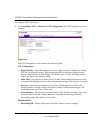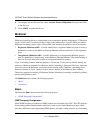
GS700AT Smart Switch Software Administration Manual
4-37 Configuring Switching Settings
v1.0, October 2008
4. To configure and test the data link, check Activate Protocol Migration in the provided field
in the first row.
5. Click APPLY to update the device.
Multicast
Multicast forwarding allows a single packet to be forwarded to multiple destinations. L2 Multicast
service is based on L2 switch receiving a single packet addressed to a specific Multicast address.
Multicast forwarding creates copies of the packet, and transmits the packets to the relevant ports.
• Registered Multicast traffic – If traffic addressed to a registered Multicast group is seen it is
handled by an entry in the Multicast Filtering Database and forwarded only to the registered
ports.
• Unregistered Multicast traffic – If traffic addressed to an unregistered Multicast group is
seen it is handled by a special entry in the Multicast Filtering Database. The default setting of
this is to flood all such traffic (traffic in unregistered Multicast groups).
Layer 2 switching forwards Multicast packets to all relevant VLAN ports by default, treating the
packet as a Multicast transmission. Multicast traffic forwarding is functional. However, irrelevant
ports also receive the Multicast, causing increased network traffic. Multicast forwarding filters
enable forwarding of Layer 2 packets to port subsets, defined in the Multicast filter database.
The device supports forwarding L2 Multicast Packets. Multicast forwarding is enabled by default,
and not configurable by user.
The Multicast menu contains the following options:
• “Basic”
• “Advanced”
Basic
The Multicast Basic menu contains the following options:
• “IGMP Snooping Configuration”
IGMP Snooping Configuration
When IGMP snooping is enabled, all IGMP packets are forwarded to the CPU. The CPU analyzes
the incoming packets and determines which ports want to join which Multicast groups, which
ports have Multicast routers generating IGMP queries, and what routing protocols are forwarding


















